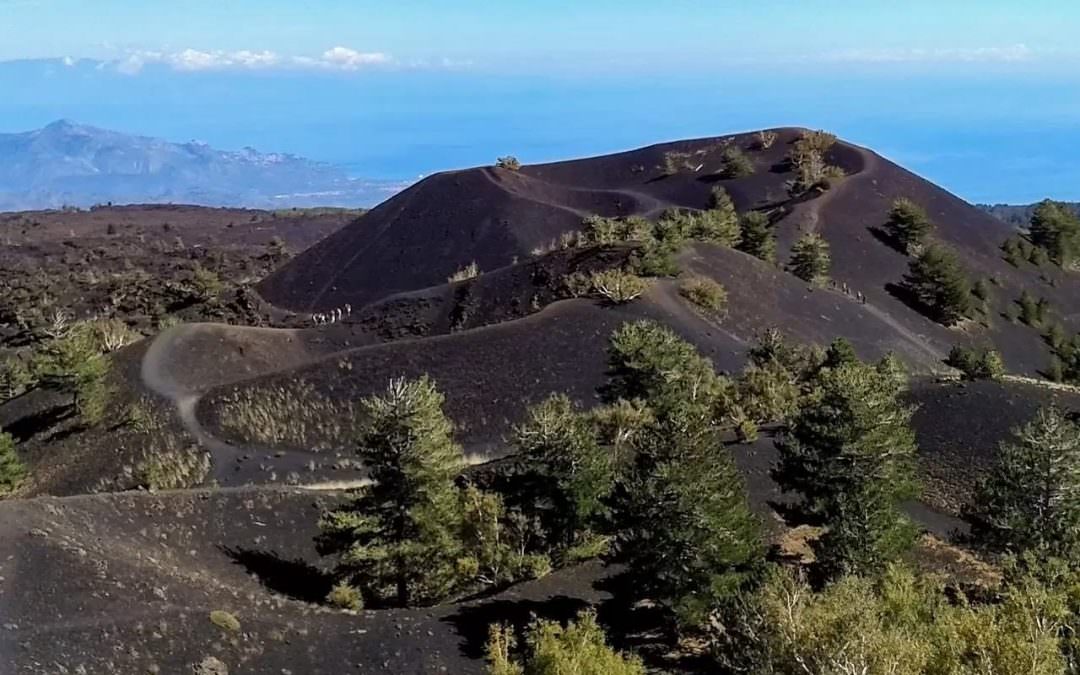At 1740 m, at Rifugio Citelli, base no. 15 of the Parco dell’Etna, we enter a grove of beech, pine and Etna birch trees. Initially, our tour is characterised by constant ups and downs. We walk through gullies of lava rock, which have been smoothed by meltwater, but also through more or less dense vegetation.
Lava tubes of Mount Etna: Serracozzo Cave
After about 1.5 km we reach the Grotta di Serracozzo, formed from one of the openings of the 1972 eruption. We explore what lies beneath the hard volcanic surface: the grotto consists of two very different parts. After a low and narrow entrance, we find ourselves between high walls, the surface smooth, almost like glass, polished smooth by the glowing hot lava… a surprising and impressive sight.
If we go further into the grotto, it becomes a tunnel of lava. The ceiling gets lower and lower until we can no longer stand upright. The appearance has changed completely: the floor is now made of slag, the ceiling is emblazoned with drops of cooled lava, the so-called dog’s teeth (denti di cane).
The Grotta di Serracozzo is a fantastic example of the approximately 190 lava tunnels that dot Etna. These caves are formed during an eruption by the outflow of the glowing (between 700 and 1100 degrees hot) and still liquid lava. As the lava flows, it cools at the surface and becomes solid, forming a shell or crust. Inside, the lava maintains its temperature because of this crust and continues to flow, sometimes for kilometres, hot and liquid. As soon as the eruption is over and no new lava comes, the tunnel empties. A new grotto has been created.
Valle del Bove
Back on the surface, we resume the path we climbed before and after about half a kilometre of ascent we reach the edge of the Valle del Bove (Ox Valley).
A breathtaking panorama opens before our eyes: the entire valley lies before us, 35 km2, carved into the eastern side of the volcano, overlaid by the lava flows of the last 47 years.
We admire a slope full of lava flows that, like immovable stone tongues, testify to how the volcano’s activity has covered this large, formerly green surface in just half a century.
On 5 April 1971, the first fissures developed into the eruptive activity that created Southeast Crater. One by one, the lava flows have flowed into the Valle del Bove, swallowing the rich vegetation that covered the valley.
If you look closely at the view, you can still see the previous structure of Etna, which collapsed about 8,000 years ago, giving the valley its shape.
At this site you can admire dykes of magma, an interesting volcanic formation found especially at this site, as well as at some extinct craters. Another peculiarity of this valley that catches the eye of the beholder is certainly the so-called pietra cicirara (chickpea stone): a stone made of lava in which countless crystals of feldspar are enclosed, much larger than those formed today.
Our tour continues towards Pizzi Deneri. We follow the edge of the Valle del Bove for a few hundred metres until we reach the 1928 craters.
One of the largest lateral craters of Etna: Monte Frumento delle Concazze
We leave the ridge, cross the lava flow of 1928 and direct our steps towards Monte Frumento delle Concazze, at 2,150 m one of the highest lateral craters of Etna, formed about 3,500 years ago.
Unlike what we have seen so far, the lava rock of the cone that rises in front of us has a reddish colouring, caused by the oxidation of the iron contained in the lava.
From this vantage point you have a beautiful view of all the Sartorius craters, 7 craters lined up like a row of buttons. We enjoy the panorama, our view sweeps over the north-east side of Etna to the sea and even as far as Calabria.
We walk to the Sartorius buttonhole and walk along its craters until we turn south to reach the forest of Etna birches (a type of birch that grows only on Etna) and the 1928 lava flow. Then we return to the Rifugio Citelli.
Tired but happy about the impressive views and the beautiful volcanic formations we finish our tour.
Until the next adventure ????
